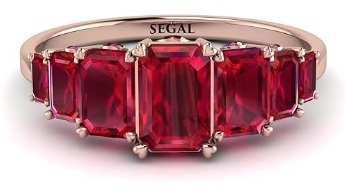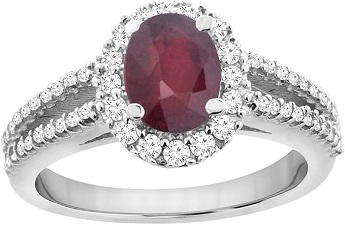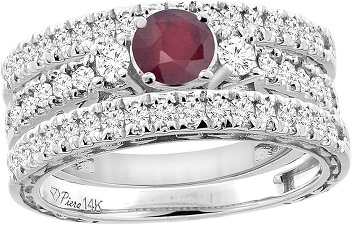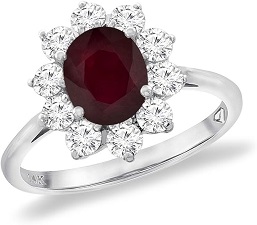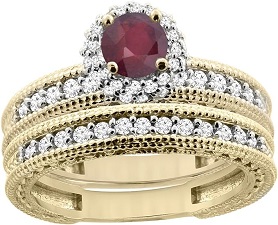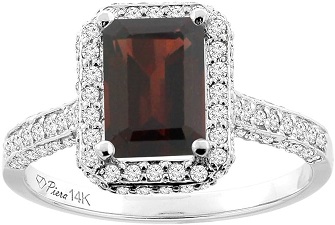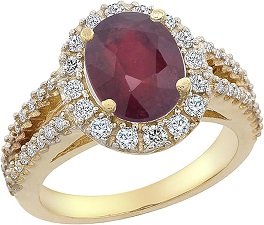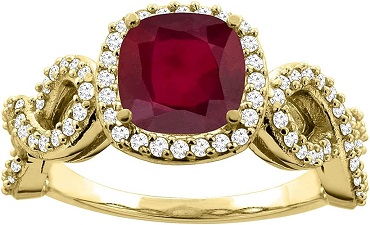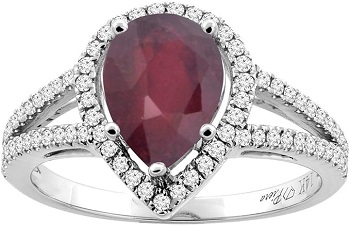Engagement Rings Ruby: The Art of Choosing the Perfect Ring
How To Choose The Right Shade Of Ruby For Your Engagement Ring.
Engagement Rings Ruby: Choosing the right shade of ruby for an engagement ring is an art form, a delicate balance of personal taste, symbolism, and gemological knowledge. In the quest for the perfect ruby, color reigns supreme. Here’s how to navigate this vibrant spectrum.
Emerald Cut Engagement Rings Ruby With Hidden Diamonds Rose Gold 14K-18K
Click On The Image
Understanding Ruby Color Spectrum
Ruby’s color spectrum is a tapestry of reds. Each shade tells a different story, from the classic pigeon blood red, a deep yet vibrant hue, to softer pinkish tones. The most prized rubies are saturated red, with a balanced mix of brightness and depth.
Personal Preference and Symbolism
Choosing a ruby shade reflects your style and the symbolism you wish to imbue in your ring. Deep, intense reds speak of passion and strength, while lighter shades resonate with gentle, romantic love. Consider what each hue symbolizes to you and your partner.
Light and Setting
Consider how different lighting conditions affect the ruby’s appearance. A well-chosen ruby should maintain its allure under various light sources. Additionally, the ring’s setting can influence the stone’s color perception. A white gold or platinum setting can make the ruby’s color pop, while yellow gold offers a warmer, more traditional look.
Quality and Rarity
While deeper shades are often more sought after and valuable, pay attention to the beauty and uniqueness of lighter rubies. Each shade carries its charm and rarity. Its color does not solely determine a ruby’s value and overall quality. Clarity and cut also play an essential role.
Matching with Skin Tone
A ruby should complement the wearer’s skin tone. Try different shades against the skin to see which enhances the hand’s natural beauty. Some may find that certain reds highlight their skin tone better than others.
Consult with a Gemologist
When in doubt, consult with a gemologist or a jewelry expert. They can provide valuable insight into the quality of different shades and help you make an informed decision.
Embrace Your Choice
Ultimately, the right shade of ruby for your engagement ring is the one that resonates with you emotionally. It symbolizes your love and commitment, so choose a shade that speaks to your heart.
In selecting the shade of ruby for your engagement ring, remember that this choice is deeply personal. It’s not just about picking a stone but choosing a symbol of your unique love story. Let the ruby’s color reflect the depth and nuances of your relationship.
14K White Gold Enhanced Genuine Ruby Split Shank Halo Engagement Ring
Click On The Image
Understand The Four Cs (Color, Cut, Carat, And Clarity) In Rings With Ruby.
In the quest to find the perfect ruby engagement ring, the Four C’s – Color, Cut, Carat, and Clarity – serve as your compass. While traditionally associated with diamonds, these criteria are equally crucial in selecting a ruby. Let’s dive into each aspect to help you make an informed choice.
Color: The Heart of a Ruby
Color is the most defining feature of a ruby. The ideal ruby exhibits a vibrant, rich red, often described as pigeon blood red. This shade represents the apex of desire in rubies, coveted for its deep yet bright hue. However, rubies also span a range of reds, from pinkish tones to deeper, almost purplish reds. The key is saturation; the more intense the color, the more valuable the ruby.
Cut: Maximizing the Ruby’s Fire
The cut of a ruby doesn’t just refer to its shape but how well it unleashes the stone’s inner light. A masterfully cut ruby will have facets reflecting light brilliantly, enhancing its color and sparkle. Unlike diamonds, where cut precision is standardized, ruby cutting prioritizes color and weight retention. Whether it’s a classic oval, a regal cushion, or a striking emerald cut, the right cut makes a ruby come alive.
Carat: Size and Its Implications
Like all gemstones, the carat weight in rubies refers to their size. But with rubies, size carries a different implication. High-quality rubies are rare in large sizes, so the carat weight significantly impacts the value. However, don’t be swayed by size alone. A smaller ruby with exceptional color and clarity can be far more valuable than a larger one with mediocre qualities.
Clarity: Balancing Perfection and Personality
Clarity in rubies doesn’t demand the same standards as diamonds. Rubies typically contain inclusions, but these should not overly diminish the stone’s transparency or brilliance. Some inclusions can contribute to the ruby’s unique character, adding to its story. When examining a ruby, look for a stone that speaks to you, where the inclusions don’t detract from its beauty but tell its unique tale.
The Balancing Act
Selecting a ruby ring is about balancing these four Cs. Each aspect plays a role in the stone’s overall appearance and value. Remember, a ruby’s charm often lies in its unique combination of these characteristics, reflecting not just a piece of jewelry but a symbol of love and a work of art. So, choose a ruby that resonates with your story and captures the essence of the love it symbolizes.
14K White Gold Diamond Enhanced Ruby Engagement 3-pc Ring Set Engraved
Click On The Image
How Ring Settings Like Bezel, Solitaire, And Diamond Halo Ring Influence A Ruby Ring’s Look
The setting of a ruby engagement ring is much more than just a functional component; it’s a canvas that enhances and complements the ruby’s innate beauty. Each setting style – halo, bezel, or solitaire – brings its unique aesthetic to the ring, transforming the overall look and feel. Let’s explore how these popular settings influence the appearance of a ruby solitaire engagement ring.
Halo Setting: Amplifying Splendor
The halo setting encircles the central ruby with a constellation of smaller diamonds or gemstones. This setting enhances the ruby’s size and brilliance and adds an opulent, glamorous touch. The surrounding gems create a luminous frame, making the ruby appear larger and more radiant. Ideal for those who adore a statement piece, the halo diamond engagement ring setting is a testament to your love.
Bezel Setting: Modern Elegance
A thin metal rim encases the ruby in a bezel setting, holding it securely in place. This setting offers a sleek, contemporary look, emphasizing the ruby’s shape and color. The metal frame protects the edges of the ruby, making it a practical choice for active lifestyles. The bezel setting is for those who seek a blend of modern design and everyday wearability, offering a clean and sophisticated profile.
Solitaire Setting: Timeless Simplicity
The solitaire setting features a single ruby mounted on the band, allowing the gemstone to take center stage. This setting is all about showcasing the ruby’s natural beauty, unadorned and uncluttered. The simplicity of the solitaire setting is its strength, offering a timeless and classic look. It’s a perfect choice for those who believe in the quiet elegance of minimalism and the power of a single, stunning gem to symbolize their love.
Prong Setting: Traditional and Versatile
The prong setting, often seen in classic engagement ring designs, involves using metal claws to hold the ruby in place. This setting allows maximum light to enter the stone, enhancing its brilliance and color. The number of prongs can vary, but jewelers typically use four to six prongs. It’s a versatile setting that works well with various ruby sizes and shapes, offering a traditional yet elegant look. Perfect for those who seek a balance between security and showcasing the ruby’s beauty, the prong setting is a popular choice for its ability to elevate the gemstone’s presence on the ring.
Choosing the Right Setting
Selecting the right setting for a ruby engagement ring involves considering the ruby’s characteristics, the wearer’s style, and the ring’s practical aspects. Whether you’re drawn to a halo’s luxurious allure, the bezel’s refined grace, or the classic charm of a solitaire, the setting you choose will profoundly impact the ring’s personality. Each setting tells a different story, framing the ruby in a narrative as unique as your love story.
14K White Gold Diamond Natural Quality Oval Ruby Engagement Ring
Click On The Image
Designing Your Ruby Engagement Ring: Going Beyond the Norm
Exploring The Possibilities With Custom Ruby Engagement Ring Designs.
When designing a custom ruby engagement ring, the possibilities are as limitless as your imagination. This journey goes beyond the standard choices, allowing you to create a piece that reflects your story and style. Let’s explore how to craft a ruby engagement ring that stands out and speaks volumes about your unique love story.
Choosing Your Ruby: The Heart of Your Ring
Selecting a suitable ruby is the first step in custom ring design. Consider the size, hue, tone, and saturation that resonate with you. Whether it’s a deep, pigeon blood red or a softer, pinkish hue, your choice of ruby sets the tone for the entire ring.
Innovative Settings: A Canvas for Creativity
The setting of your ruby is where creativity comes into play. Consider more unique designs beyond the classic halo, bezel, solitaire, and prong settings. Think about using asymmetrical settings, incorporating geometric patterns, or even designing a setting that tells a story or symbolizes something special to you and your partner.
Mixing Metals: A Modern Twist
Feel free to mix different metals in your custom design. Combining rose gold with platinum or yellow gold with white gold can create a visually stunning and contemporary look. This approach adds visual interest and allows the ring to complement various styles and tastes.
Accent Stones: Adding Personal Flair
Accent stones can add another layer of meaning and beauty to your ruby engagement ring. Consider diamonds for classic elegance or other colored gemstones for a more eclectic look. The placement and type of these stones can symbolize important aspects of your relationship, like the date you met or your partner’s birthstone.
Engravings and Personalization: A Unique Signature
Engravings offer a personal touch that makes your ring genuinely one-of-a-kind. From a special date, a meaningful phrase, or even your partner’s fingerprint, these details add a layer of personalization that celebrates your unique bond.
Consulting with a Skilled Jeweler
Partner with a skilled jeweler who understands your vision. A good jeweler will bring your ideas to life and provide valuable guidance on the practical aspects of ring design, ensuring your ring is beautiful, wearable, and durable.
Designing a custom ruby engagement ring is an exciting process that allows you to infuse your personal touch into every aspect of the ring. From the choice of ruby to the final design details, each element comes together to create a symbol of your love that is unique to your own story.
14K Yellow Gold Diamond Enhanced Genuine Ruby Round 4mm Engagement Ring
Click On The Image
Creating Sparkle In Your Engagement Rings Ruby: How Diamonds Can Complement a Ruby Center Stone In a Ruby and Diamond Ring.
While designing a ruby engagement ring, incorporating diamonds can elevate the ring’s elegance and sparkle. Diamonds, with their unparalleled brilliance, can accentuate the rich color of a ruby, creating a harmonious and luxurious look. Let’s explore how diamonds complement a ruby center stone in a captivating and timeless way.
Halo Setting: A Circle of Light
A popular way to incorporate diamonds is through a halo setting, where small diamonds encircle the ruby. The halo setting enhances the ruby’s size and presence, adding a dazzling light frame. The contrast between the ruby’s deep red and the diamond’s sparkling white creates an eye-catching and sophisticated look.
Side Stones: Symmetry and Balance
Adding diamonds as side stones can bring symmetry and balance to the ring. Whether in a three-stone setting, with diamonds flanking the ruby, or as part of a more intricate design, these diamonds complement the ruby’s vibrancy. They can be cut in various shapes to match or contrast the ruby, adding layers of visual interest.
Pavé Band: Subtle Elegance
Incorporating diamonds into the band with a pavé setting can add a subtle yet elegant sparkle. This design features small diamonds embedded along the band, creating a glittering effect that leads the eye toward the center ruby. It’s a sophisticated way to enhance the ring without overshadowing the ruby’s natural beauty.
Diamond Accents: Personalized Touches
Using diamond accents in unique placements can add personalized touches to the ring. These could be strategically placed around the ruby or on the band, adding sparkle in unexpected ways. This approach allows for creativity in design, making the ring truly one-of-a-kind.
Balancing the Overall Design
When adding diamonds to a ruby engagement ring, balance is vital. The goal is to enhance the ruby’s beauty without overwhelming it. Choose diamond sizes and placements that complement the ruby rather than compete. The diamonds should chorus to the ruby’s solo, supporting and elevating its natural splendor.
Quality and Color Harmony
Consider the quality and color of the diamonds in relation to the ruby. Opt for diamonds that match clarity and color to ensure a harmonious look. The right diamonds will not only add sparkle but also bring out the depth and nuances of the ruby’s color.
Incorporating diamonds into a ruby engagement ring is a beautiful way to create contrast, add sparkle, and enhance the overall aesthetic of the ring. With thoughtful design, diamonds can elevate a ruby center stone, creating a luxurious and deeply meaningful piece.
14K White Gold Enhanced Genuine Ruby Engagement Ring Octagon
Click On The Image
Diving Deep into The Allure of Ruby Engagement Rings
Understanding the symbolism and significance of the ruby gemstone
The Symbolic Essence of Rubies.
Rubies, celebrated for their vibrant red hue, symbolize profound emotions like love, passion, and courage. Ancient beliefs held that these gemstones protected against evil and brought good fortune. People also thought rubies had healing properties, enhancing vitality and mental clarity. Today, the symbolism of ruby engagement rings has evolved, now representing unique love stories and signifying an unbreakable commitment between partners.
Historical Significance.
Historically, cultures worldwide have held rubies highly esteemed as stones of nobility. Their rich color and rarity contributed to their high value. Notably, the Chinese emperor Kublai Khan is said to have offered an entire city for a stunning ruby. Legends ascribe various powers to rubies, such as igniting an unquenchable flame, boiling water, and protecting against plagues. In Burma, warriors believed that embedding rubies in their flesh rendered them invincible. In Sanskrit, people refer to this red gemstone as “ratnaraj,” meaning “king of precious stones.”
Ruby’s Mystical and Emotional Connection.
Beyond their historical and cultural importance, rubies also deeply connect to life’s sensual pleasures. People believed them to ignite the blood and stimulate the heart, encompassing a range of love experiences from passionate to mystical. People have associated rubies with faithful and passionate commitment for centuries, making them perfect for engagement rings or wedding gifts. Some believe that rubies can deepen relationships and even boost fertility.
The Physical Composition.
On the physical side, red corundum, an aluminum oxide mineral, makes up rubies, with chromium responsible for their rich red color. Rubies rank among the four precious gemstones, alongside diamonds, emeralds, and sapphires. Historically, people often confused rubies with other red stones like red spinels, tourmalines, and garnets until the early 1800s.
14K Yellow Gold Diamond Enhanced Genuine Ruby Engagement Ring Oval
Click On The Image
Exploring The Cultural History of Ruby in Engagement Rings
Historically, the intertwining of rubies with eternal love and commitment has marked their significance in the realm of engagement rings. While diamond rings remain popular, ruby engagement rings offer a unique and equally heartfelt expression of affection.
Different cultures attribute distinct symbolic meanings to rubies. For example, Hindu tradition views them as symbols of protection, power, and passion, underscoring their diverse significance across societies.
For centuries, rubies have been featured in the engagement ring tradition, symbolizing the ability to give and receive unconditional love. Known as the “stone of the heart,” they are believed to influence passion and romance, thus enhancing the romantic essence of the engagement ritual.
The allure of rubies extends from ancient times to the present. Historical records indicate that traders sold rubies along the Silk Route in China as early as 200 B.C. Their lasting popularity stems from their durability and the captivating intensity of their color.
Comparing ruby engagement rings with common alternatives.
Morganite:
A softer alternative to ruby’s vibrant red, morganite offers a feminine and romantic appeal. Still, it is less durable (7.5 to 8 on the Mohs scale) than ruby’s robustness (9 on the Mohs scale).
Garnet:
While garnets provide a deep red hue similar to rubies, they are less hard (6.5 to 7.5 on the Mohs scale) and more affordable, making them a budget-friendly option.
Pearl:
Pearls exude elegance but are much softer (2.5 to 4.5 on the Mohs scale) than rubies, requiring more careful handling.
Moissanite:
Offering similar hardness (9.5 on the Mohs scale) and brilliance to rubies, moissanite is a durable and glamorous alternative, albeit with a different aesthetic appeal.
Quartz:
While quartz has a mystical and varied color appeal, its lower hardness (7 on the Mohs scale) and different aesthetics make it a more spiritual alternative to the classic ruby.
Lapis Lazuli:
This blue stone offers an opulent look but is softer (5 to 5.5 on the Mohs scale) and less durable than rubies, suitable for those seeking a different color and style.
Tourmaline:
Tourmaline provides a unique color mix and good durability (7 to 7.5 on the Mohs scale) but lacks the intense red and higher hardness of rubies.
Topaz:
Topaz is a versatile and durable option with many colors and a hardness of 8, but it doesn’t offer the same rich red tone as rubies.
Opal:
Opals have unique colors and patterns but are softer (5.5 to 6.5 on the Mohs scale) and less durable than rubies, making them suitable for those seeking a distinct and varied aesthetic.
Onyx:
Black onyx offers a sleek, modern alternative (6 to 7 on the Mohs scale) but lacks the vibrant color and higher hardness of rubies.
Peridot:
Symbolizing love, peridot (6.5 to 7 on the Mohs scale) offers a bright green hue, differing vastly in color and slightly less in durability than rubies.
Labradorite:
With a hardness of 6 to 6.5 and a range of colors, labradorite is a less durable and differently colored alternative to rubies, suitable for those seeking a magical appeal.
Aquamarine:
This blue gemstone (7.5 to 8 on the Mohs scale) offers good durability but differs in color and lacks the rich red tone of rubies.
Sunstone:
With a hardness of 6 to 7 and unique colors, sunstones provide a distinct look compared to rubies, suitable for those seeking a less traditional option.
Tsavorite:
This green garnet (7 to 7.5 on the Mohs scale) offers a vibrant alternative but lacks the iconic red and slightly higher hardness of rubies.
Tanzanite:
Rare and with a unique hue (6.5 to 7 on the Mohs scale), tanzanite provides a different aesthetic but is less durable and lacks the classic red of rubies.
Citrine:
With a cheerful yellow hue and a hardness of 7, citrine offers a different color and slightly less durability than rubies and is suitable for those seeking a sunny alternative.
14K White Gold Enhanced 7mm Cushion Cut Ruby Engagement Eternity Ring for Women
Click On The Image
Shop With Confidence: Key Features To Consider When Buying A Engagement Rings Ruby.
Color:
The soul of a ruby engagement ring lies in its color. The ideal ruby flaunts a deep, vivid red, often with hints of purple or blue, which enhances its richness. The most sought-after rubies exhibit a strong, saturated hue without being too dark. Remember, the more intense and pure the red, the more valuable this precious gemstone is.
Clarity:
While rubies are rarely flawless, a high-quality ruby should have no visible inclusions to the naked eye. Minor inclusions are acceptable but shouldn’t detract from the gemstone’s overall beauty or brilliance. A clear, lustrous, fine ruby symbolizes an unblemished love.
Cut:
The cut of a ruby is pivotal in showcasing its brilliance and color. Fine craftsmanship ensures that the cut enhances the ruby’s natural beauty. Popular choices like the cushion cut or oval ruby maximize the stone’s brilliance and contribute to the ring’s overall aesthetic appeal.
Carat Weight:
Like all precious stones, we measure the weight of a ruby in carats. Larger rubies are rare, making them more valuable. However, don’t just go by size alone; a smaller ruby with superior color and clarity can be more desirable than a larger stone of lesser quality.
Setting:
Your setting should protect the ruby while allowing it to shine. Consider a setting that complements the ruby’s shape and maximizes its visibility, like a prong or bezel setting. The metal can also impact the look of the stone—rose gold accentuates a ruby’s warmth, while platinum or white gold highlights its fiery hue.
Metal:
The choice of metal for your ruby engagement ring can dramatically alter its look. Yellow gold offers a classic, timeless appeal, while white gold or platinum provides a modern, sleek frame. Rose gold is becoming increasingly popular for its warm, romantic feel and pairs beautifully with the deep red of a ruby.
Design and Style:
Consider the wearer’s style when choosing a ruby ring. From art deco and vintage designs that exude old-world charm to contemporary styles that speak of modern elegance, the ring should reflect the personality and taste of its wearer.
Certification and Ethical Sourcing:
Ensure your ruby is ethically sourced and comes with a certification from a reputable gemological lab. Such a certificate guarantees the stone’s authenticity and quality, providing peace of mind that your investment is sound.
Maintenance and Care:
Ruby, being a durable stone, is suitable for everyday wear. However, regular cleaning and proper care are essential to maintain its luster and longevity. Avoid exposure to harsh chemicals and physical knocks.
Unmasking The Myth: Lab-created Vs Natural Rubies.
When embarking on the journey to choose the perfect ruby engagement ring, you encounter a crucial decision: lab-created or natural rubies. This choice often comes wrapped in myths and misconceptions. Let’s unmask these and understand the true essence of both options.
Origin:
Natural rubies, forged by the hands of Mother Nature, carry a story millions of years old. Formed under the earth’s crust, they embody a legacy of geological processes. In contrast, lab-created rubies emerge from modern alchemy, born in controlled environments replicating natural conditions. These stones mirror their natural counterparts’ physical and chemical properties but are younger in creation.
Appearance and Quality:
Lab-created rubies boast remarkable clarity and color consistency, often surpassing natural ones. However, natural rubies hold a unique charm. Each stone carries its inclusions and hue variations, making them unique treasures.
Environmental and Ethical Considerations:
Lab-created rubies offer an eco-friendly and ethical alternative. Their production requires fewer resources and minimizes environmental impact. Additionally, they sidestep the ethical concerns sometimes associated with natural gemstone mining.
Value and Investment:
Natural rubies, especially those with exceptional color and clarity, typically hold more value. They are seen not just as jewelry but as investments and heirlooms. On the other hand, lab-created rubies provide affordability without compromising on the visual appeal, making them accessible to a broader audience.
Care and Maintenance:
Both natural and lab-created rubies require care to maintain their luster. Regular cleaning and avoiding harsh chemicals are essential, irrespective of their origin.
Certification and Trust:
Whether you choose a natural or lab-created ruby, ensure it comes with certification from a reputable lab. This step is crucial for authenticity and quality assurance.
Choosing between lab-created and natural rubies concerns personal values, aesthetics, and budget. Remember, the beauty of a ruby engagement ring lies not just in its physical attributes but in the love and commitment it symbolizes. Whether natural or lab-created, a ruby ring can be an emblem of your unique love story, sparkling with memories and meaning for years to come.
14K Gold Diamond Natural Quality Ruby Engagement Ring Pear Shape
Click On The Image
Moving Forward: Caring For Your Ruby Engagement Ring
Essential Tips For Preserving Your Beautiful Ruby Engagement Ring.
Your ruby engagement ring symbolizes love and is a valuable piece that needs proper care to maintain its beauty and longevity. Below are some essential tips to help you preserve your ruby engagement ring, ensuring it continues to sparkle and enchant for years to come.
Regular Cleaning: Maintaining Brilliance
Regular cleaning is crucial to keep your ruby engagement ring looking its best. Use an ultra-soft-bristle brush and a mild soap solution to gently scrub the ruby and the setting. Rinse it under lukewarm water and pat dry with a soft cloth. This routine helps remove everyday dirt and oils that can dull the ruby’s natural brilliance.
Professional Check-Ups: Ensuring Durability
Schedule annual check-ups with a professional jeweler. They can inspect the ring for any loose settings or damage to the ruby or band. Regular professional maintenance ensures you address potential issues early, keeping your ring pristine.
Avoid Harsh Chemicals: Protecting the Ruby
Be mindful of exposure to harsh chemicals, which can damage the ruby and the metal setting. Remove your ring when cleaning, swimming, or applying cosmetics and lotions. Chemicals can erode the metal and dull the ruby’s surface, diminishing its sparkle.
Safe Storage: Preventing Scratches
When not wearing your ring, store it safely. A fabric-lined jewelry box with separate compartments is ideal. Keeping the ring in a separate space prevents it from scratching or getting scratched by other jewelry. Remember, even though rubies are durable, they can still suffer from scuffs and scratches.
Mindful Wearing: Daily Care
Be conscious of your activities while wearing the ring. Though rubies are rugged and durable, they are not indestructible. Avoid wearing the ring during high-impact activities or when working with abrasive materials. Mindful wearing helps prevent accidental knocks or damage.
Engagement Rings Ruby: Insuring and Securing Its Value.
Consider insuring your ruby engagement ring. Insurance can protect against loss, theft, or damage, providing peace of mind. Ensure that the policy covers the full replacement value and understand the process for claims.
Caring for your ruby engagement ring requires regular maintenance, professional inspections, and mindful usage. By following these essential tips, you ensure that your ring remains as beautiful and significant as the day it was first slipped onto your finger, safeguarding its sparkle and sentiment for the future.
The importance of a good warranty and insurance for your gemstone ring.
Ensuring the safety and longevity of your ruby engagement ring extends beyond regular care and maintenance. A good warranty and insurance protect your cherished piece against unforeseen circumstances. Let us explore why these safeguards are essential and how they can offer peace of mind.
Understanding Warranty: Your Safety Net.
A warranty for your ruby ring acts as a safety net, covering potential issues like manufacturing defects or problems with the setting. When selecting your ring, inquire about the warranty terms.
- Coverage Details: Understand what the warranty covers. Does it include repairs for damage, or does it extend to replacing the ruby if it’s lost from its setting?
- Duration: Check the duration of the warranty. A more extended warranty period reflects the jeweler’s confidence in their craftsmanship.
- Maintenance Requirements: Some contracts may require regular professional inspections to remain valid. Ensure you’re aware of these conditions.
The Role of Insurance: Comprehensive Protection
While a warranty covers specific issues, insurance provides broader protection for your ruby engagement ring.
- Loss and Theft: Insurance typically covers loss or theft, offering a replacement or compensation.
- Damage: It also protects against accidental damage. A standard warranty covers this.
- Global Coverage: Most insurance policies provide global coverage, protecting your ring no matter where you are.
Choosing the Right Insurance Policy
Selecting the right insurance policy requires research and understanding of your needs.
- Appraisal: Get your ring appraised by a certified gemologist to determine its current market value. This appraisal is crucial for getting the right amount of coverage.
- Policy Details: Understand the policy’s specifics, including deductibles, coverage limits, and claim procedures.
- Premiums: Compare premiums from different insurers. While cost is a factor, don’t compromise on the extent of coverage for a lower premium.
Engagement Rings Ruby: Regular Updates on Policy and Appraisal.
Keep your insurance policy and ring appraisal updated. As the market value of gemstones can fluctuate, regular appraisals ensure your coverage matches the ring’s current value.
Investing in a good warranty and insurance for your ruby engagement ring is essential to caring for your precious piece. It provides financial protection against loss, theft, or damage and gives you confidence and peace of mind. This foresight safeguards your symbol of love.
Take The Next Step: Match Your Ruby Engagement Ring To A Wedding Band.
Matching your ruby engagement ring to a wedding band is a delightful journey in harmonizing two significant jewelry pieces. This process involves balancing individuality and unity, ensuring the engagement ring and the wedding band complement each other. Let’s explore the art of perfectly pairing your ruby engagement ring with a wedding band.
Considering Style and Design
The first step is to consider the style and design of your ruby engagement ring and the potential wedding band.
- Complementary Designs: Look for a wedding band that complements the design of your engagement ring. If your engagement ring is intricate, you might opt for a more spartan wedding band to avoid overshadowing it.
- Matching Metals: It’s often aesthetically pleasing to match the metal of the wedding band with your engagement ring. The match creates a cohesive look between the two pieces.
Contour or Straight Bands
Decide between a contour band, which fits the shape of your engagement ring, and a straight band.
- Contour Bands: These are ideal if your engagement ring has a unique shape or large gemstone that might not sit flush with a straight band.
- Straight Bands: A classic choice that can match various engagement ring styles. Straight bands offer versatility and can be worn alone or stacked with other rings.
Accentuating with Gemstones
Consider incorporating gemstones into your wedding band to echo the ruby in your engagement ring.
- Matching Rubies: Adding smaller rubies to your wedding band can create a beautiful symmetry with your engagement ring.
- Diamond Accents: Consider a wedding band with tiny diamonds for a more subtle look. The diamonds provide a lovely contrast to the ruby while adding extra sparkle.
Balancing Width and Proportions
Pay attention to the width and proportions of the wedding band in relation to your engagement ring.
- Proportional Width: Choose a band that is proportional in width to your engagement ring for a balanced look.
- Stacking Considerations: If you wear multiple rings on the same finger, consider thinner bands to ensure comfort and a harmonious stack.
Engagement Rings Ruby: Personalization and Engravings.
Personalizing your wedding band with engravings can add a sentimental touch. This could be a special date, initials, or a meaningful quote that resonates with your relationship.
Or See More Ring Varieties As Follows:
